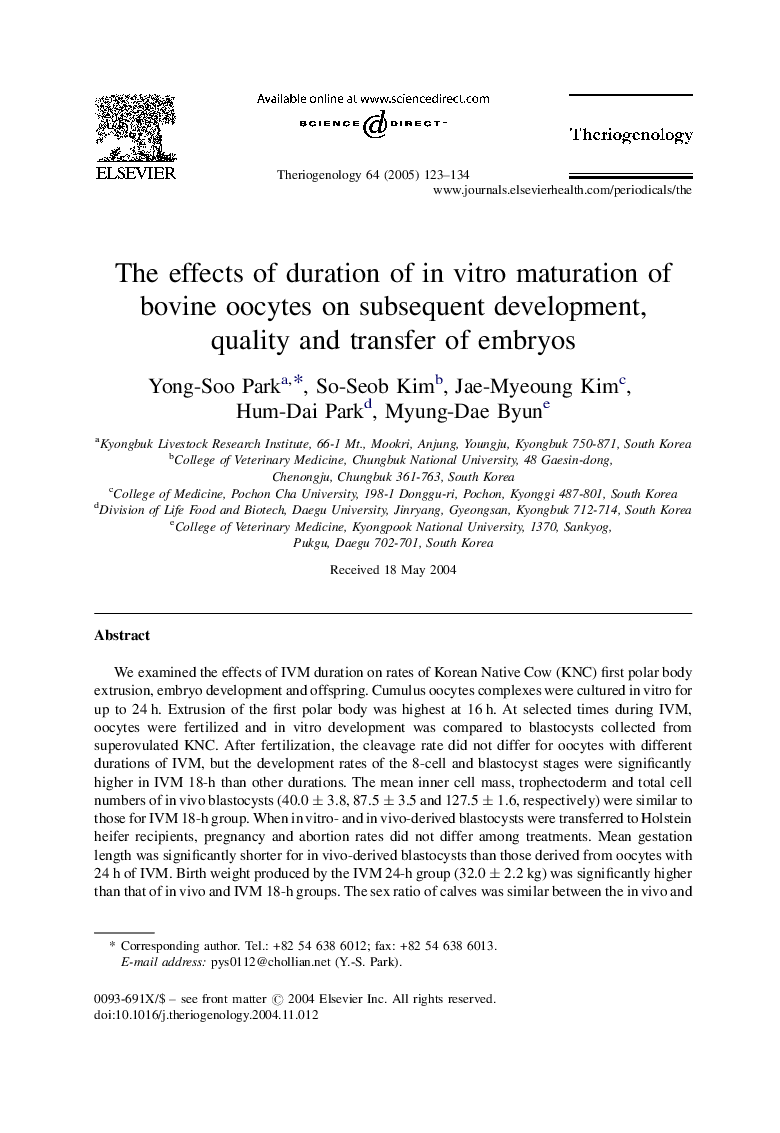| کد مقاله | کد نشریه | سال انتشار | مقاله انگلیسی | نسخه تمام متن |
|---|---|---|---|---|
| 10893932 | 1082240 | 2005 | 12 صفحه PDF | دانلود رایگان |
عنوان انگلیسی مقاله ISI
The effects of duration of in vitro maturation of bovine oocytes on subsequent development, quality and transfer of embryos
دانلود مقاله + سفارش ترجمه
دانلود مقاله ISI انگلیسی
رایگان برای ایرانیان
کلمات کلیدی
موضوعات مرتبط
علوم زیستی و بیوفناوری
علوم کشاورزی و بیولوژیک
علوم دامی و جانورشناسی
پیش نمایش صفحه اول مقاله

چکیده انگلیسی
We examined the effects of IVM duration on rates of Korean Native Cow (KNC) first polar body extrusion, embryo development and offspring. Cumulus oocytes complexes were cultured in vitro for up to 24 h. Extrusion of the first polar body was highest at 16 h. At selected times during IVM, oocytes were fertilized and in vitro development was compared to blastocysts collected from superovulated KNC. After fertilization, the cleavage rate did not differ for oocytes with different durations of IVM, but the development rates of the 8-cell and blastocyst stages were significantly higher in IVM 18-h than other durations. The mean inner cell mass, trophectoderm and total cell numbers of in vivo blastocysts (40.0 ± 3.8, 87.5 ± 3.5 and 127.5 ± 1.6, respectively) were similar to those for IVM 18-h group. When in vitro- and in vivo-derived blastocysts were transferred to Holstein heifer recipients, pregnancy and abortion rates did not differ among treatments. Mean gestation length was significantly shorter for in vivo-derived blastocysts than those derived from oocytes with 24 h of IVM. Birth weight produced by the IVM 24-h group (32.0 ± 2.2 kg) was significantly higher than that of in vivo and IVM 18-h groups. The sex ratio of calves was similar between the in vivo and the IVM 24-h group, but all calves derived from the IVM 18-h group were males. Therefore, duration of bovine oocyte IVM played a critical role in embryo development and blastocyst cell number. In addition, it also affected birth weight and sex ratio.
ناشر
Database: Elsevier - ScienceDirect (ساینس دایرکت)
Journal: Theriogenology - Volume 64, Issue 1, 1 July 2005, Pages 123-134
Journal: Theriogenology - Volume 64, Issue 1, 1 July 2005, Pages 123-134
نویسندگان
Yong-Soo Park, So-Seob Kim, Jae-Myeoung Kim, Hum-Dai Park, Myung-Dae Byun,